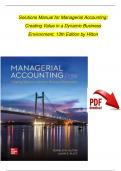Exam (elaborations)
Solutions Manual For Managerial Accounting: Creating Value in a Dynamic Business Environment, 13th Edition by Ronald W. Hilton, David E. Platt, All Chapters 1 - 17, Complete Newest Version
- Course
- Institution
- Book
Solutions Manual For Managerial Accounting: Creating Value in a Dynamic Business Environment, 13th Edition by Ronald W. Hilton, David E. Platt, All Chapters 1 - 17, Complete Newest Version Solutions Manual For Managerial Accounting: Creating Value in a Dynamic Business Environment, 13th Edition ...
[Show more]




